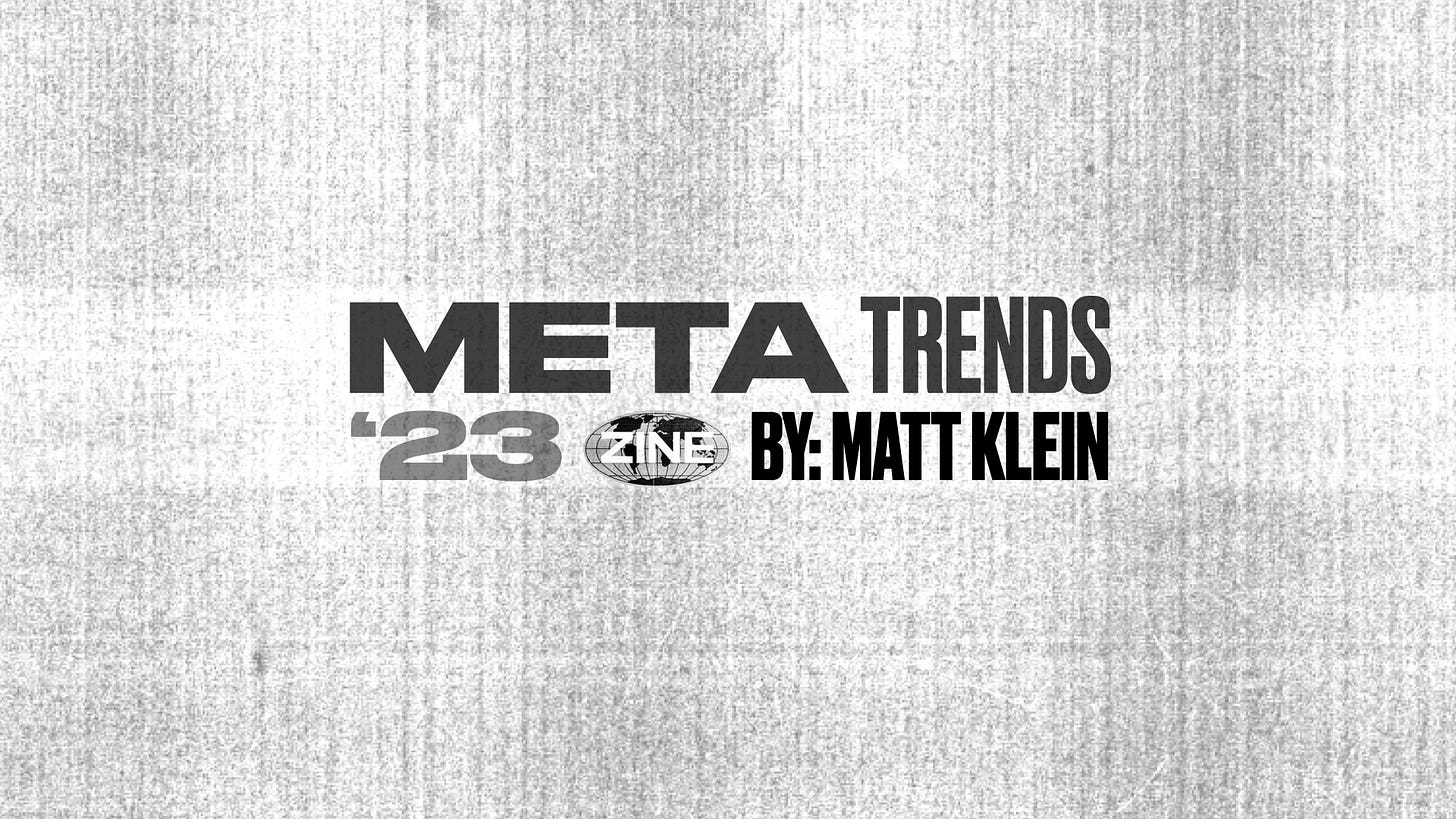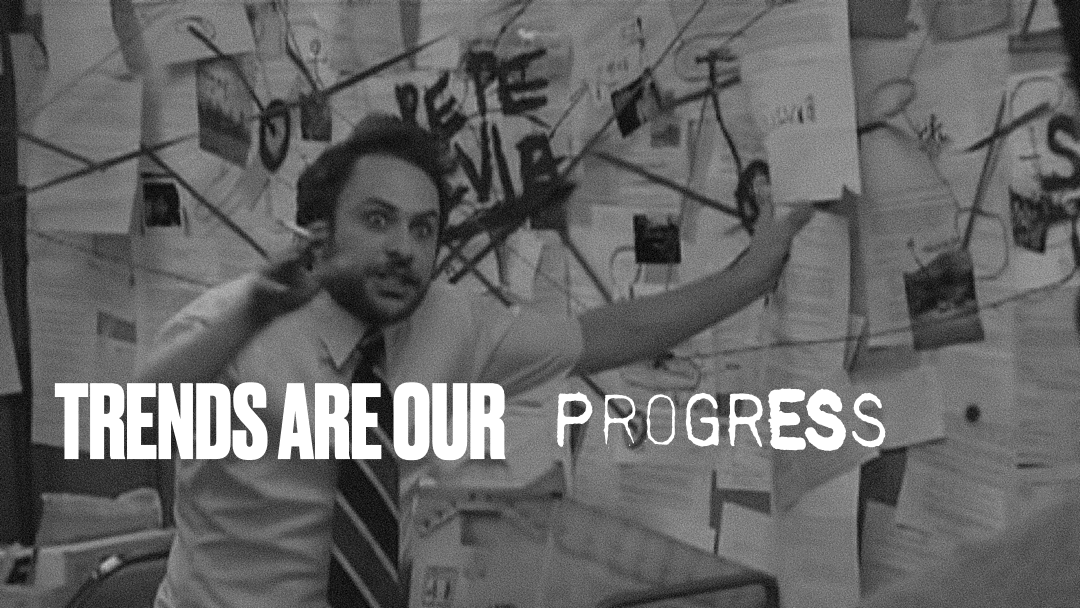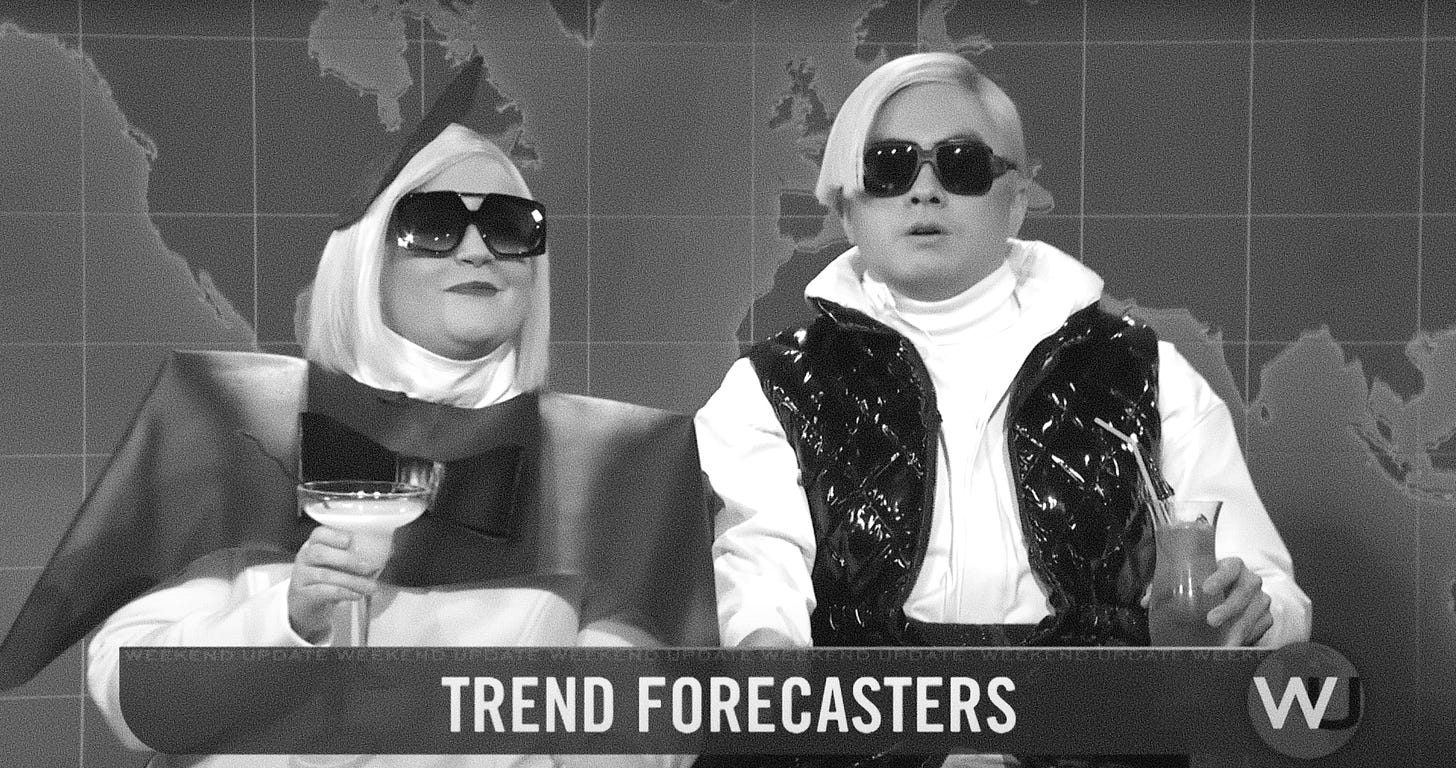The META Trending Trends: 02023
An Analysis of 50+ Global Trend Forecasts → 16 Most Reported Social Shifts
Discordianism & Meliorism
02023’s Prologue
It’s the 60s.
Amidst a backdrop of psychedelic tripping — voluntary and involuntary — the Vietnam War, moon landing, nuke preparations, and JFK assassination rip a hole through our collective reality.
What is even real?
Then comes Manson, dialing it all to 11.
Reality is too strange to be this real.
There must be order behind it all.
Conspiracy. Explanation. Reason.
In the wake of these events, “Discordianism” emerges: a pseudo-religion, mocking the rest of them. It declares that chaos and disharmony are essential to our reality, just as other religions claim harmony and order to be.
Its founders reason: instead of organization, the foundation of our reality is strife, chaos and discord. It’s simply better to embrace this confusion than to fight it. Years later, its descendants invent the Illuminati, parodying conspiracy and disorienting all further.
Cut to Kek & Trump. Brexit. Epstein. COVID-19. January 6th.
Disorientation is now our norm – we’re chronically dazed, drowning in unpredictability. For many, fictional explanations were (and remain) more believable than truth itself.
Reality is too strange to be this real.
More recently, headlines covering contested elections, NFTs, and a metaverse were replaced by those covering shadow-bans, verification checks, and generative AI. Yet the question remains:
What is even real?
Featured on 60 Minutes this past year, the Birds Aren’t Real movement crystallized peak-conspiracy and Gen Z’s Discordian, ironic clap-back. As I write this, #corecore is the meme of the moment — a montage of clashing clips commenting on the absurdism and chaos of our time.
Meanwhile, Nathan Fielder’s The Rehearsal struck a nerve. Distorted reality is now packaged and served back as entertainment.
From college admissions, lavish lifestyles, and startup funding, to chess champs, crypto execs and political resumes, the age of the sly grifter is now one of the blatant bullshitter.
Colorado decriminalized psilocybin, and Merriam Webster Dictionary named “Gaslight” 2022’s word of the year.
Truth is a mirage.
In response to a ubiquity of falsehoods, we grasp for answers: mysticism, UFOs, conspiracies. Seemingly stretches, but explanations nonetheless. Call it cultural control.
As professional thinkers, it’s easy to look down on culture and snicker at QAnon believers.
But we’re lost in this chaos too.
Pursuing answers along with the rest, we obsess over another compass: trends.
Friend, we’re all conspirators.
Trends are our patterns. Our Explanations. Our order and organization amidst chaos.
We’re each theorists with red string. Navigators looking to the stars, spinning narratives via spotted constellations — desperate to make sense of our increasingly complex and unpredictable world.
This rampant paranoia results in reported micro-trend nothings: empty -cores, “vibe shifts,” and aesthetics that dominate our discourse. But it’s just self-reassuring signal and sense amidst a hallucinated reality.
When there’s a disturbing reversal of social progress (from the rise of antisemitism, to the overturn of Roe v. Wade), of course we’ll dream of progress — no matter how inconsequential it may be. Pop another In/Out list. It’s junk food change.
Stuck in a spin cycle of nauseating nostalgia, our desperation for forwardness is laughable. No. Literally. It’s now a joke. This past year, SNL’s Aidy Bryant and Bowen Yang played trend forecasters. This wasn’t a one off, peripheral, 10-to-1 absurdist sketch. This was the pinnacle of mainstream mockery: a recurring bit on cable TV’s Weekend Update.
A viral folder of collected industry trend reports is a signal in itself. Catching them all is now a feat. Over the last five years, the number of published trend reports has roughly tripled. But this year, less than half of published trend reports include a methodology. And only two reports of 50 had the rigor to look backwards and reflect upon what they shared a year earlier.
As turmoil is torqued up, so too will the presence of trends.
And to author a preferred future, we first need to understand our current, chaotic moment.
So... we need to do this right. And there is a right way.
To conduct cultural analysis correctly (accurately and ethically) we need many things: a coherent and consistent methodology, quantitative rigor, a diversity of input and collaboration, iteration (learning from past findings), a removal of organizational and personal bias or agendas, reflection, risk, realism, a curiosity about the fringe and overlooked, and a vision of a preferred future.
This field and these reports are upstream of significant innovation and budget. If it weren’t the case, why would so many organizations author them, or so many people read and share them?
Mindfulness is paramount. These reports are self-fulfilling prophecies. We report on trends that already exist, and create a future centering these trends.
This cycle explains the minimal deviation of reported trends over the last five years.
Cultural analysis is an ouroboros — a snake eating its own tail. We make culture as much as we study it. Several 2023 trend reports feature my writing as their support. This report — an analysis of existing reports — will also inform thinking. That’s just how culture works.
To hedge against the risk of repetition, stagnation and crap reporting, we require two more ingredients: accountability and imagination.
When 100 organizations claim to be the authority on what’s next — yet only pump hype further, inject ads of their services, and cluelessly report the same observations from five years earlier — self and public accountability is required.
These are competing voices hoping to shape their future. Is “theirs” the one we want? Or does theirs even have a vision? We don’t have to listen nor act upon a forecast if we don’t want to.
Which brings us to the second need: imagination.
Is this narrative just another comforting illusion amidst what’s really in front of us: just more chaos? I hope not. But...
Accepting chaos does not mean forfeiting control.
Tolerate not knowing what’s hidden around the corner, and work towards imagining what we want to see there.
We often forget that we maintain control over our systems and culture.
Nothing is fixed.
“Manifesting” is in fact possible.
Instead of using reports as the answer key, we can scrutinize them as input when drafting our own blueprints.
In the face of overwhelming Discordianism, “Meliorism” is our antidote: in between optimism and pessimism, it declares that our world can only improve with human effort.
So instead of reporting what’s already trending, how about we interrogate it? Or better yet, instead of predicting things we don’t even want — and considering it predetermined — we author stories and strategies for what we want the future to hold?
We’re at the wheel.
And if anyone’s to push us out from the rut and steer us in a more equitable, sustainable, diverse, mindful and exciting future, it’s you.
Q: WTF are META Trends?
A: META Trends are a distillation of the industry’s reported trends — an annual meta-analysis of 50+ global cultural forecasts.
This META report is a reflection on the most frequently reported trends, and commentary on the practice of trend forecasting itself.
My intent from the first 2017 META Report was that we can leverage reliability (all available reports) as a proxy for trend accuracy.
But over the years I’ve found significant systemic flaws in the reports — bias, lack of methods, etc. “Accuracy” has an asterisk.
While META Trends still provide value by helping us understand the collective’s outlook (with a ~3yr horizon), META Trends must not be considered the final product, but the beginning.
The edges are the sharpest, and the fringes are the future.
So... Three ways to approach The META Trends Reports:
Consider all that’s reported as table stakes – catch up
Interrogate what’s presented — consider all other angles
Use this report as a filter — consider what’s not discussed
META Methodology
Read 50+ 2023 global reports and parsed 550+ trends in Excel 1
Analyzed each trend description and color-coordinated themes
ID’d 16 META Trends (i.e. the largest themes, trending trends)
Designated ~10x words/phrases to rep each of the 16 META Trends
Used NWO.ai to score each collection of keywords for a rank 2
“Corp Rank” = published reports’ trend mention frequency vs.
“AI Rank” = NWO.ai’s proprietary “Impact Score” for keywords
Applied The Overlooked Framework to interrogate each META Trend
Input META Trend write-ups into DALL·E for impressionist visuals
AI’s Intro
“Life is like a big roller coaster. Sometimes it's peaceful and calm, but sometimes it can get really wild and crazy. Right now, it feels like it's been wild and crazy for a while. People are trying to find ways to feel like they are in control and make things better. Technology is giving us lots of ways to take back control and make us feel like we can handle things. It lets people help shape the world around them and get more out of the things they love. Things may look different after a big change, and sometimes it's hard to know what to do during these crazy times, but people are finding new ways to do things and make things better.”






